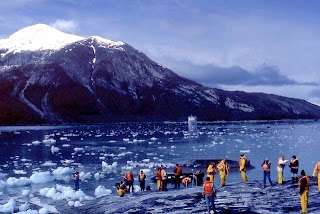On both the
Navimag ferry from Puerto Montt to Puerto Natales, and the
Cruceros Australis cruises through

the
fjords of Tierra del Fuego, the quality of services is remarkably good. By that I don't mean the food and drink, which are good enough (for the price) on the
Evangelistas and well-above-average to exceptional on the (far more expensive)
Mare Australis and
Via Australis.
Rather, I mean the information and even the entertainment available on board. Unlike many cruise ships, they are not trivial - the guides on both routes present competent to sophisticated accounts of Patagonian natural history, discovery and exploration, and even climate change.
I have done the Navimag trip at least half a dozen times, and the Cruceros Australis route three times. As the former is primarily

transportation, through admittedly spectacular scenery, it does not generally include shore excursions - with the exception of an occasional stopover at
Puerto Edén. The latter, by contrast, offers one or two shore-based excursions every day by Zodiac shuttle, such as the short but steep hike to the monument to shipwrecked sailors at stormy
Cape Horn (pictured here), which I visited just yesterday.
That means the
Evangelistas has more time to fill for passengers on board, especially when bad weather limits visibility, and what's interesting is how the entertainment has changed. The
Evangelistas has always shown movies, for instance, but they were often conventional Hollywood fare such as the
Terminator series. Aboard the Cruceros Australis ships, the films are documentaries such as George Butler’s
Endurance (2000), about the epic rescue of British explorer Ernest Shackleton's crew from Elephant Island, off the Antarctic Peninsula.
The content of Navimag's offerings, though, has become more daring, with outstanding Latin American and especially Chilean films with political content. On my most recent voyage, for instance, they showed Brazilian Walter Salles's award-winner
The Motorcycle Diaries (2004), about the young Ernesto "Che" Guevara's 1950s overland trip through South America, but it was not the most interesting of the bunch.
Rather, Navimag also chose two Chilean films which, not so many years ago, would have been difficult to make and, until even more recently, unlikely to have been shown aboard ship. Director Andrés Wood's
Machuca (2004) tells the 1970s tale of a poor scholarship student at an exclusive Santiago school during
Salvador Allende’s chaotic Unidad Popular government and
General Augusto Pinochet’s subsequent dictatorship. Set during the near-war of 1978, Alex Bowen's
Mi Mejor Enemigo (My Best Enemy) (2005) is the tragicomic story of Argentine and Chilean army patrols uncertain what side of the border they're on in the nearly featureless Patagonian steppe.
While both films are critical of the Argentine and Chilean dictatorships of the period, neither of them backs off from dealing with complexities that defy both left-wing and right-wing clichés and ideology, and that's what makes both of them worth seeing. What's certain, though, is that neither of them would likely have received a screening in this context until 2006, when General Pinochet died at the age of 91. Still, Navimag deserves enormous credit for showing serious films that feature someone other than the
Austrian governor of my home state of California.
 World Heritage Site for its vernacular architecture), the Atacama desert port of Iquique (with its characteristic wooden Victorians), and the Patagonian port of Punta Arenas, the gateway to Torres del Paine (for air passengers) and the fjords of Tierra del Fuego (by sea). Even those cities often have plenty of eyesores including plastic signage and a proliferation of electric and telephone cables that clutter many streets.
World Heritage Site for its vernacular architecture), the Atacama desert port of Iquique (with its characteristic wooden Victorians), and the Patagonian port of Punta Arenas, the gateway to Torres del Paine (for air passengers) and the fjords of Tierra del Fuego (by sea). Even those cities often have plenty of eyesores including plastic signage and a proliferation of electric and telephone cables that clutter many streets.









